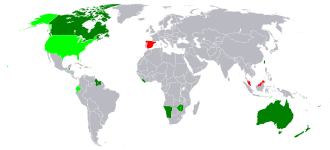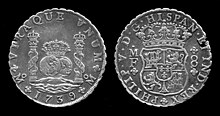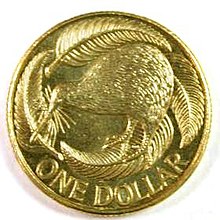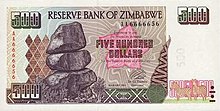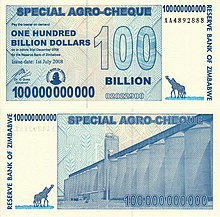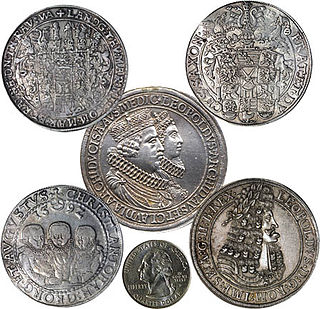
A thaler or taler is one of the large silver coins minted in the states and territories of the Holy Roman Empire and the Habsburg monarchy during the Early Modern period. A thaler size silver coin has a diameter of about 40 mm and a weight of about 25 to 30 grams. The word is shortened from Joachimsthaler, the original thaler coin minted in Joachimsthal, Bohemia, from 1520.

A penny is a coin or a unit of currency in various countries. Borrowed from the Carolingian denarius, it is usually the smallest denomination within a currency system. Presently, it is the formal name of the British penny (abbr. p) and the de facto name of the American one-cent coin (abbr. ¢) as well as the informal Irish designation of the 1 cent euro coin (abbr. c). Due to inflation, pennies have lost virtually all their purchasing power and are often viewed as an expensive burden to merchants, banks, government mints and the public in general.

The peso is the monetary unit of several Spanish-speaking countries in Latin America, as well as the Philippines. Originating in the Spanish Empire, the word peso translates to "weight". In most countries of the Americas, the symbol commonly known as dollar sign, "$", was originally used as an abbreviation of "pesos" and later adopted by the dollar. The dollar itself actually originated from the peso or Spanish dollar in the late 18th century. The sign "₱" is used in the Philippines.

The Spanish dollar, also known as the piece of eight, is a silver coin of approximately 38 mm (1.5 in) diameter worth eight Spanish reales. It was minted in the Spanish Empire following a monetary reform in 1497 with content 25.563 g (0.8219 ozt) fine silver. It was widely used as the first international currency because of its uniformity in standard and milling characteristics. Some countries countermarked the Spanish dollar so it could be used as their local currency.

The dollar coin is a United States coin with a face value of one United States dollar. Dollar coins have been minted in the United States in gold, silver, and base metal versions. Dollar coins were first minted in the United States in 1794.

The eagle was a United States $10 gold coin issued by the United States Mint from 1795 to 1933.

The Belize dollar is the official currency in Belize. It is normally abbreviated with the dollar sign $, or alternatively BZ$ to distinguish it from other dollar-denominated currencies.

The Coinage Act of 1792, passed by the United States Congress on April 2, 1792, created the United States dollar as the country's standard unit of money, established the United States Mint, and regulated the coinage of the United States. This act established the silver dollar as the unit of money in the United States, declared it to be lawful tender, and created a decimal system for U.S. currency.
Coinage Act is a stock short title used for legislation in the United Kingdom and the United States related to coinage.
The fineness of a precious metal object represents the weight of fine metal therein, in proportion to the total weight which includes alloying base metals and any impurities. Alloy metals are added to increase hardness and durability of coins and jewelry, alter colors, decrease the cost per weight, or avoid the cost of high-purity refinement. For example, copper is added to the precious metal silver to make a more durable alloy for use in coins, housewares and jewelry. Coin silver, which was used for making silver coins in the past, contains 90% silver and 10% copper, by mass. Sterling silver contains 92.5% silver and 7.5% of other metals, usually copper, by mass.
The history of the United States dollar began with moves by the Founding Fathers of the United States of America to establish a national currency based on the Spanish silver dollar, which had been in use in the North American colonies of the Kingdom of Great Britain for over 100 years prior to the United States Declaration of Independence. The new Congress's Coinage Act of 1792 established the United States dollar as the country's standard unit of money, creating the United States Mint tasked with producing and circulating coinage. Initially defined under a bimetallic standard in terms of a fixed quantity of silver or gold, it formally adopted the gold standard in 1900, and finally eliminated all links to gold in 1971.

The Flowing Hair dollar was the first dollar coin issued by the United States federal government. The coin was minted in 1794 and 1795; its size and weight were based on the Spanish dollar, which was popular in trade throughout the Americas.
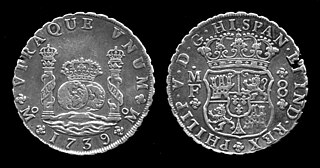
The silver standard is a monetary system in which the standard economic unit of account is a fixed weight of silver. Silver was far more widespread than gold as the monetary standard worldwide, from the Sumerians c. 3000 BC until 1873. Following the discovery in the 16th century of large deposits of silver at the Cerro Rico in Potosí, Bolivia, an international silver standard came into existence in conjunction with the Spanish pieces of eight. These silver dollar coins played the role of an international trading currency for nearly four hundred years.

Silver coins are one of the oldest mass-produced form of coinage. Silver has been used as a coinage metal since the times of the Greeks; their silver drachmas were popular trade coins. The ancient Persians used silver coins between 612–330 BC. Before 1797, British pennies were made of silver.
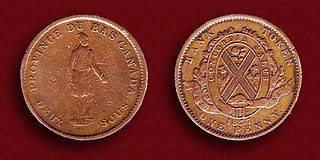
The pound was the currency of the Canadas until 1858. It was subdivided into 20 shillings (s), each of 12 pence (d). In Lower Canada, the sou was used, equivalent to a halfpenny. Although the £sd accounting system had its origins in sterling, the Canadian pound was never at par with sterling's pound.

The United States dollar is the official currency of the United States and several other countries. The Coinage Act of 1792 introduced the U.S. dollar at par with the Spanish silver dollar, divided it into 100 cents, and authorized the minting of coins denominated in dollars and cents. U.S. banknotes are issued in the form of Federal Reserve Notes, popularly called greenbacks due to their predominantly green color.
The Coinage Act of 1834 was passed by the United States Congress on June 28, 1834. It raised the silver-to-gold weight ratio from its 1792 level of 15:1 to 16:1 thus setting the mint price for silver at a level below its international market price.
The history and development of British currency in the Middle East emerged from the 19th century. British involvement in the Middle East began with the Aden Settlement in 1839. The British East India Company established an anti-piracy station in Aden to protect British shipping that was sailing to and from India. The Trucial States were similarly brought into the British Empire as a base for suppressing sea piracy in the Persian Gulf. Involvement in the region expanded to Egypt because of the Suez canal, as well as to Bahrain, Qatar, and Muscat. Kuwait was added in 1899 because of fears about the proposed Berlin-Baghdad Railway. There was a growing fear in the United Kingdom that Germany was a rising power, and there was concern about the implications of access to the Persian Gulf that would arise from the Berlin-Baghdad Railway. After the First World War the British influence in the Middle East reached its fullest extent with the inclusion of Palestine, Transjordan and Iraq.

The Coinage Act of 1853, 10 Stat. 160, was a piece of legislation passed by the United States Congress which lowered the silver content of the silver half dime, dime, quarter dollar, and half dollar, and authorized a three dollar gold piece. Although intending to stabilize the country's silver shortage, it, in effect, pushed the United States closer to abandoning bimetallism entirely and adopting the gold standard.
The Reichsmünzfuß was a coinage standard or Münzfuß officially adopted for general use in the Holy Roman Empire. Different imperial coin standards were defined for different types of coins.
